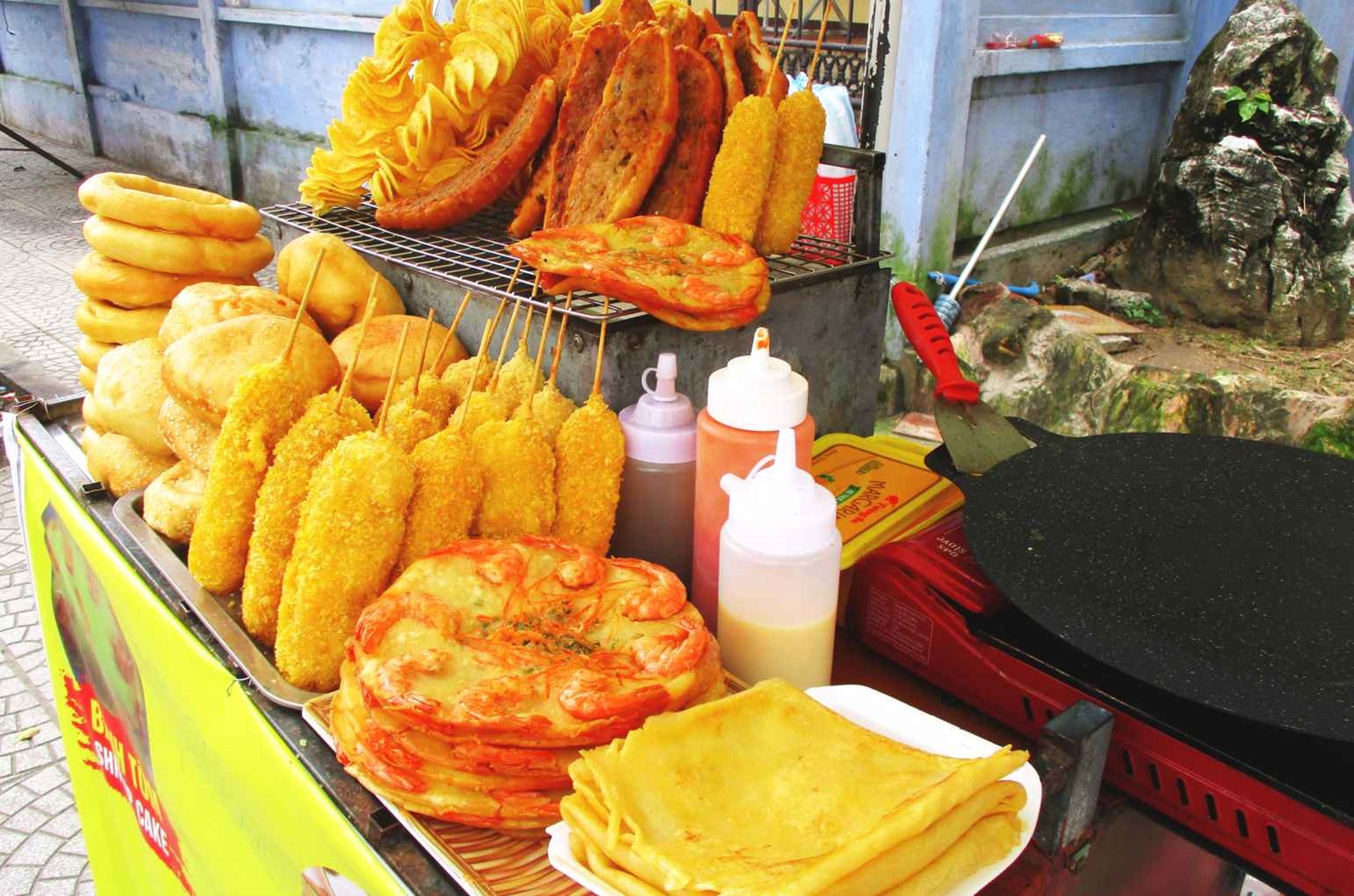A culinary trip across Southeast Asia
Zac O’Yeah shares his experience where seafood menus and the edible insect movement led to unexpected encounters
 Snail fest in Ho Chi Minh City, Vietnam (Source: Getty Images)
Snail fest in Ho Chi Minh City, Vietnam (Source: Getty Images)Walking out of Danang Airport one steaming November evening, I look for a cab to the next town – which is Hoi An. Basically, all I know about central Vietnam is that said UNESCO world heritage spot is also the newest foodie hotspot.
I’d been fantasising about barbecued dogs, boiled cats, mashed hedgehogs and snake heart ‘sushi’, but it turns out at dinnertime in Hoi An that foreign animal rights activists had put paid to that sort of traditional food. I make do with normal noodles – in Vietnam they are even served in the hotel’s breakfast buffet so one is quite noodlified all day. After those hearty breakfasts, I don’t get hungry until nightfall when Hoi An’s street scene heats up. I go for charcoal-grilled baby octopus and baked quail eggs at the riverside market, knowing I am going to love Vietnam.
There’s something subtle about Vietnamese cuisine, perhaps because the country used to be a French colony. It also has improved on recipes borrowed from neighbours like China. And although the ubiquitous fish sauce (nuoc-mam) is used as a flavour enhancer as well as a dip sauce, spice levels never exceed what may be termed as good taste. Unlike say in Thailand, here herbs are preferred to chilli-overkill. Menus emphasise fresh seafood, a reflection of the long coastline and many rivers crisscrossing the land. My top choice is Mai Fish (45 Nguyen Thi Minh Khai) that showcases Vietnamese home-cooking (but alas, no dog).
Weekend over, I catch the southbound train from Danang, through green landscapes dotted with jungly hills, to Saigon (or Ho Chi Minh City as it is formally known these days). The train is a delight, with tidy sleeper cabins and an onboard cookshop where tourists can drink beer and savour snacks all night.
I check into an elegant but affordable art deco hotel in the main street: Huong Sen offers a generous breakfast buffet with select Vietnamese delicacies every morning and the rooftop restaurant overlooks Graham Greene’s former home where he wrote The Quiet American over four winters.
 The landscape is flat and comprises rice fields and more rice fields (Credit: Zac O’Yeah)
The landscape is flat and comprises rice fields and more rice fields (Credit: Zac O’Yeah)
The most popular roadside snack is banhmi – ‘Saigon sandwich’ – which is a crispy baguette stuffed with all manner of heavenly pâtés topped with juicy cold cuts and piquant pickles. It’s hardly surprising then that Saigon happens to be Southeast Asia’s culinary capital, even my sort of neighbour Greene praised its “good food, good wine, & tremendous friendliness.”
I can only agree, but eventually must make a move on to the Cambodian border. It takes hours but the taxi is comfortable, with sofas that would easily seat dozens of Vietnamese travellers – but I have it all to myself so I can lie down whenever I feel post-prandial. The landscape is flat and comprises rice fields and more rice fields, but it’s always been my dream to cross the Mekong – I’m just flabbergasted at its vastness and even more surprised when we arrive at another equally wide, bonus river. I ask the driver what’s this and he laughs merrily, ‘Mekong number two! Is all Mekong!’
In Cambodia, my first halt is Kampot, a French-style coastal resort town best known as the pepper capital. I check into a pricey heritage hotel but it’s near the old market – as all travellers know, the freshest food is found in such areas. Cambodia is no exception and I can’t help but gravitate to the same pub day after day: with the somewhat un-Cambodian name Happy Chef Pizza it offers breezy outdoor seating and the menu is as varied as it gets, with everything from fish-saucy salads, crabs fried with local green pepper and palm sugar, Khmer stir-fries as well as ketchup pizzas with hotdog-toppings (but no actual dog à la carte).
It’s just a couple of hours by taxi to Phnom Penh so en route I check out sights such as the ancient Angkor Borei, capital of a now forgotten kingdom that may have been fully Tamilian once. The most prominent sight still standing, on a hilltop known as Phnom Da, is a great temple dedicated to Vishnu. From there, my taxi follows the Mekong northeast until we hit Phnom Penh, a pleasant modern capital where I find myself a dirt-cheap budget lodge with the Indian-sounding name Naveen, right across from the royal palace.
It’s also around the corner from the riverfront bars, where I become a habitué at Pink Elephant (347 Preah Sisowath Quay). Here, finally, I find exotic nourishment in the form of a pizza topped with genuine dog slices. It tastes like mutton. Or chicken. Anyway, Phnom Penh has a colonial-era art deco-market that’s home to many lively food stalls at one of which I order Cambodia’s ‘national dish’ prahok-kti, a soupy Khmer hotpot of fermented fish with pig’s blood and noodles. It is generally eaten for breakfast, so one needs to get to the market early to taste the best.
Eventually, it’s time to tick the fabled Angkor Vat off the bucket list and, as it is a long journey, I hop onto an AC bus. The company, which caters to tourists on this popular route, sends a tuktuk to pick me up from the hotel and is great value – all for just 13 US dollars (which is the preferred currency in Cambodia).
On the way, there’s a lunch break at Skuon, a nondescript village globally known for what is referred to as ‘Cambodia’s answer to caviar’ which I obviously must try: this turns out to be MSG-marinated hairy tarantulas deep-fried in garlic oil. It’s like chewing on a meatless miniature crab, its exoskeleton crunchy and the coagulated belly contents gooey. As sides, I get sautéed silk worms and crickets. It takes beer to wash it down, but luckily in Cambodia beer is both cheap and excellent.
 Having had my fill of Angkor Vat, a taxi takes me to the Thai border where it’s possible to get visa on arrival (Credit: Zac O’Yeah)
Having had my fill of Angkor Vat, a taxi takes me to the Thai border where it’s possible to get visa on arrival (Credit: Zac O’Yeah)
The country is also at the forefront of the edible insect movement – it’s been estimated by the Food and Agriculture Organization (of the United Nations) that within 30 years, mankind will have to depend more on insects for protein, though in the case of Cambodia, insect-eating is reckoned to stem from the harsh Khmer Rouge period when peasants starved. After this edifying lunch, it’s another couple of hours to the world-famous temple complex, which, of course, takes days to explore and is impossible to even begin describing.
My nearby hotel has a cool pool, so I rest at the end of each day by floating in it. Also in the same village, I discover an all-you-can-eat barbecue, Meng BBQ (Wat Bo Village), with a buffet of raw seafood and meats that diners cook seated around a chhnang phnom pleung, a coal-fired grill and hot-broth-combo whose name translates as ‘meat volcano’. While broiling crocodile fillets on top with their fat dripping into the broth, I multitask by poaching live shrimp that flounder spastically in the bubbling bath below. When in Rome…
Having had my fill of Angkor Vat, a taxi takes me to the Thai border where it’s possible to get visa on arrival – if one’s lucky – but at the bus station on the other side no buses seem to be leaving for anywhere, so I end up paying for another cab to the capital Bangkok, where I’m immediately stuck in endless traffic jams. As afternoon turns to night, I congratulate myself at having had the forethought to book a room at the delightful 1950s art deco-hotel The Atlanta, which sits in a quiet alley off the main drag Sukhumvit. Then, I spend a couple of days doing museums and… what else but eating? I try touristically bland pad thai in the backpacker area’s Khao San Road where I also put away deep-fried spring rolls and deep-fried other greasy things.
So, looking for the soul of Thai food, I’ve heard much about the papaya salad known as som tam. It belongs to the Isan province and around the corner from my hotel there’s the Esaan Nation Kitchen (390, 1 Sukhumvit) where the waitress, with a concerned look, asks: ‘Are you sure? It’s Thai spicy.’
I should have taken the hint. It messes up my stomach – over-spiced with chilli flakes, extremely sour from unripe papaya slices, bitter kaffir lime leaves, pungent fermented shrimp paste, and many other scary ingredients drenched in overwhelmingly sharp tamarind juice, setting my mouth on fire and my tummy gets nuked. Luckily, the trip is over and with tummy in shreds (though I had much great food before I reached Thailand), I board the flight looking forward to a homely meal of rice and sambar the next day.
Zac O’Yeah is a Swedish detective novelist based in Bengaluru



- 01
- 02
- 03
- 04
- 05



























